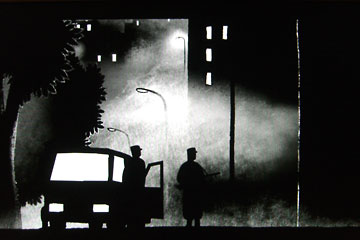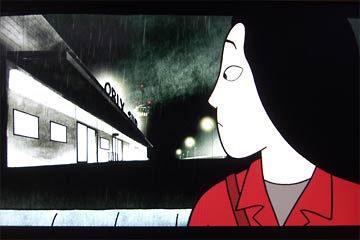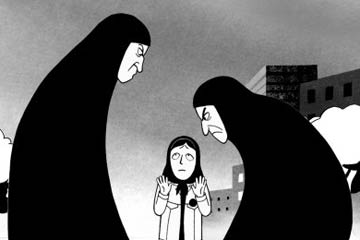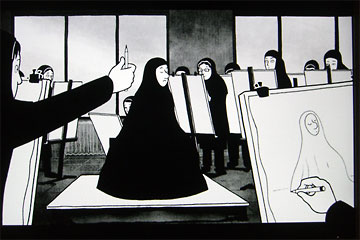Persepolis
The comic book/graphic novel Persepolis tells the story of a young girl growing up in Iran, leaving, returning, and ultimately leaving again for good. I just watched the animated movie based on the book and was impressed by both the story and the visual telling of it.
 The mostly black and white film was created using hand-drawn animation, an impressive feat shown in one of the "extras" on the DVD. I went back and watched again, and can hardly believe that every line was inked by hand with such precision and consistency that there's no trace of shakiness.
The mostly black and white film was created using hand-drawn animation, an impressive feat shown in one of the "extras" on the DVD. I went back and watched again, and can hardly believe that every line was inked by hand with such precision and consistency that there's no trace of shakiness.
But then the whole film is a work of art, with beautifully drawn backgrounds reminiscent of German Expressionists, another connection explained in the extras.
The film's directors, Vincent Paronnaud and Marjane Satrapi (also the author), chose black and white to stay true to the comic form of the original. They also wanted to create a more abstract, universal world in which the story emerged from its specific location in Iran. They wanted to make a film about people living in Iran, but not just about Iran.
 Three segments were created in color, basically the beginning, middle and end of the movie. The color scenes represent the present, with the rest of the story told in black and white as flashbacks.
Three segments were created in color, basically the beginning, middle and end of the movie. The color scenes represent the present, with the rest of the story told in black and white as flashbacks.
By design the color interludes are quite mundane, showing a grown-up Marjane at the Paris airport. At this point her life seems in a state of suspended animation. She reminisces on the real drama of her life which plays out in black and white.
 The strong graphic style throughout sometimes becomes nearly abstract, as you can see here with the dark threatening shapes of the womens' bodies that form a pair of hands holding in the little Marjane.
The strong graphic style throughout sometimes becomes nearly abstract, as you can see here with the dark threatening shapes of the womens' bodies that form a pair of hands holding in the little Marjane.
Even though the characters are drawn simply, with little detail, the overall effect is quite dramatic.
 Despite showing the harsh realities of life in an oppressive society—especially for women— Satrapi's sense of humor constantly surfaces.
Despite showing the harsh realities of life in an oppressive society—especially for women— Satrapi's sense of humor constantly surfaces.
Here, in an art class she finally explodes about the ridiculousness of drawing a model who looks the same from every angle—except for her nose!
Other school scenes show young girls who look very different to an American eye acting just as silly and rebellious as any Cleveland teen. It's these moments that make the point that it's not about strange-looking foreigners, it's about us as people.
Read the book, see the film:
The Complete Persepolis
by Marjane Satrapi
Persepolis, the movie, by Marjane Satrapi and Vincent Paronnaud (watch trailer)
Top |
|
![]()